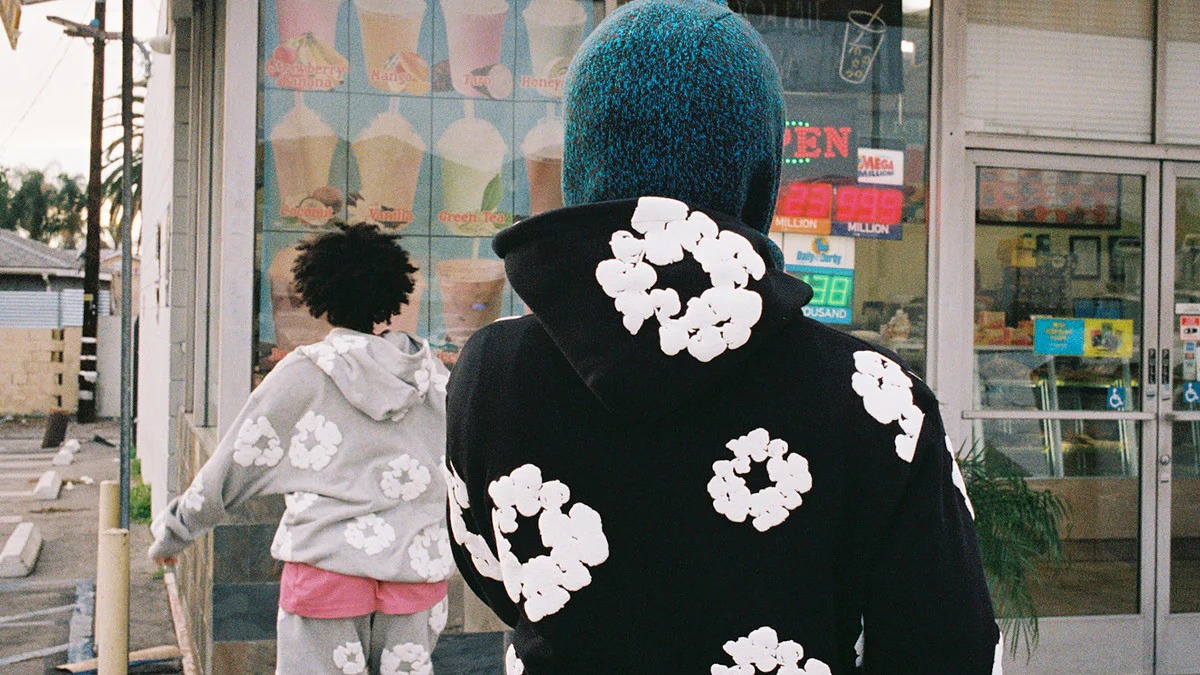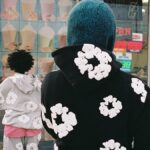Denim has always been more than just a fabric—it’s a cultural symbol. From the rugged workwear of the 19th century to the rebellious youth movements of the 20th, denim has evolved alongside society, reflecting both struggle and style. Yet, few brands have redefined its meaning as profoundly as Denim Tears, the visionary label founded by denim tear Emory in 2019. Through a blend of storytelling, history, and activism, Denim Tears has reshaped the cultural and emotional context of denim, turning it from a symbol of Americana into a platform for truth, healing, and artistic expression.By challenging traditional norms of design, production, and meaning, Denim Tears has transformed denim into a canvas for cultural conversation. The brand is not merely about fashion—it’s about reclamation, education, and resistance. This exploration examines how Denim Tears has disrupted the conventions of denim, from its historical reinterpretation of the fabric’s origins to its bold collaborations and its unique blend of streetwear and fine art.
1. Reclaiming Denim’s Historical Roots
For most of fashion history, denim has been celebrated as the quintessential American fabric—a representation of freedom, individualism, and hard work. Yet, what often goes unspoken is that denim’s origin story is deeply intertwined with the history of enslaved labor and Black suffering. The cotton used in early denim production came from plantations where enslaved Africans toiled under brutal conditions.
Tremaine Emory’s work with Denim Tears confronts this reality head-on. His debut Levi’s “Cotton Wreath” collection (2020) made a bold statement by embedding cotton wreath embroidery into Levi’s iconic 501 jeans and trucker jackets. The wreath, a recurring Denim Tears motif, symbolizes both mourning and remembrance—it is a tribute to the enslaved people whose labor built the foundation of the denim industry.
By bringing this painful history to the surface, Emory reframes denim not as a symbol of American freedom but as a material born from exploitation. This recontextualization challenges consumers to see fashion as a record of history, not just an aesthetic choice. In doing so, Denim Tears redefines authenticity—not through vintage washes or distressing, but through truth-telling.
2. The Aesthetics of Resistance
Denim Tears rejects conventional beauty standards in denim design. While most brands prioritize uniformity, trend alignment, and consumer appeal, Emory embraces imperfection, asymmetry, and storytelling through texture and symbol. Each piece feels intentionally handcrafted, soulful, and personal.
The brand’s designs often incorporate religious iconography, African-inspired motifs, and text-based graphics, transforming garments into wearable art. The imagery of crosses, cotton flowers, and script references speaks to both spiritual endurance and cultural reclamation. Rather than using denim to project luxury or rebellion, Emory uses it to express grief, pride, and collective memory.
This aesthetic of resistance subverts what denim traditionally represents in Western culture. Where jeans were once associated with rugged individualism or mass consumerism, Denim Tears reframes them as communal artifacts—vessels for shared history and identity.
3. Merging Streetwear with Fine Art
Denim Tears exists at the crossroads of fashion, art, and activism. Emory’s work cannot be confined to any single category—his designs often resemble museum exhibits more than seasonal collections. Each release functions as a narrative installation, where every stitch and print carries symbolic meaning.
Emory’s collaborations with brands such as Converse, Stüssy, and Dior have further blurred these lines. In the “Dior Tears” capsule (2023), Emory partnered with Kim Jones to reinterpret European luxury through an African-American lens. Silk shirts and embroidered denim celebrated the African diaspora’s contributions to global culture, juxtaposing couture craftsmanship with historical storytelling.
Similarly, the Converse “Plantation” collection (2021) confronted America’s history of racial oppression through a footwear and apparel capsule inspired by plantation workwear. The collaboration transformed a casual sneaker brand into a platform for cultural education—something unheard of in traditional denim or streetwear collaborations.
These projects show that Denim Tears doesn’t chase trends; it creates cultural dialogue. By merging artistic expression with historical awareness, the brand has elevated denim to a form of intellectual and emotional engagement.
4. Redefining Luxury and Value
Traditional denim culture has long been dominated by the idea that value comes from craftsmanship, rarity, or brand prestige. Denim Tears challenges this notion by proposing that value comes from meaning. A pair of Denim Tears jeans, with its embroidered cotton motifs and historical symbolism, isn’t valuable because of its materials or exclusivity—it’s valuable because it tells a story that transcends fashion.
This redefinition of luxury resonates deeply in a time when many consumers are seeking authenticity and depth. Emory’s approach dismantles the hierarchy between “high fashion” and “streetwear,” suggesting that true luxury lies in cultural consciousness. His work pushes audiences to ask: What do we really value in fashion—the label, or the message?
5. Challenging the Fashion Industry’s Power Structures
Beyond design, Denim Tears also challenges traditional power dynamics in fashion. Emory has been vocal about systemic inequities within the industry, from lack of representation in executive roles to the exploitation of Black culture without fair acknowledgment or compensation.
When Emory briefly served as the creative director for Supreme in 2022–2023, his experience underscored these tensions. His eventual departure, reportedly due to creative and ethical conflicts, highlighted the difficulties of maintaining integrity in corporate fashion structures. Through Denim Tears, however, Emory retains full creative control—allowing him to build a brand that stands on principle rather than profit.
This stance has inspired a new generation of independent designers to view fashion as an act of resistance, not just a business. By owning his narrative, Emory challenges traditional ideas of who gets to tell cultural stories and profit from them.
6. The Power of Limited Edition Storytelling
Denim Tears has mastered the art of limited edition releases, but unlike other streetwear brands, scarcity here is not about hype—it’s about focus. Each collection, whether the “Church” capsule or the “Black Jesus” drop, carries a clear emotional and historical message. The limited production underscores the idea that these pieces are not commodities but artifacts of culture.
Collectors and fans recognize this distinction. To own a piece of Denim Tears is to hold a piece of history—an acknowledgment of struggle and creativity passed through generations. This approach challenges traditional denim branding, where scarcity often serves financial ends, not intellectual or emotional ones.
7. A Global, Diasporic Perspective
Denim Tears’ influence extends far beyond American borders. Emory’s designs explore themes of the African diaspora, creating connections between continents, generations, and identities. By doing so, the brand challenges the Western monopoly on denim culture and asserts that Black creativity is global.
Future projects may further bridge African craftsmanship and American denim heritage, reinforcing the idea that fashion’s future lies in cross-cultural collaboration rather than appropriation. This global outlook pushes the conversation around denim from national pride to collective humanity.
8. The Emotional Dimension of Denim
Traditional denim brands often focus on nostalgia or ruggedness, but Denim Tears taps into something more intimate: emotion. Emory’s pieces are deeply personal—they reflect trauma, faith, hope, and love. The brand reminds us that fashion can be an act of healing.
In interviews, Emory has described Denim Tears as a “spiritual project,” not just a clothing line. The cotton wreath, the gospel-inspired imagery, and the references to ancestry all speak to a desire for restoration—of memory, dignity, and connection. In this way, Denim Tears challenges the notion of denim as a material of rebellion and recasts it as one of reconciliation.
9. The Future: Continuing to Defy Boundaries
The future of Denim Tears will likely see even Denim Tears Sweatshirt greater experimentation. As fashion becomes more digital and global, Emory may explore virtual storytelling, sustainable craftsmanship, and collaborations that continue to challenge the industry’s ethical and creative norms.Yet, the brand’s foundation will remain the same: using denim as a vehicle for truth. In a world oversaturated with fast fashion, Denim Tears stands apart by asking hard questions—about history, responsibility, and what it means to wear meaning on your body.
Conclusion
Denim Tears is not just reimagining denim—it’s rewriting its story. Through historical awareness, artistic integrity, and cultural activism, Tremaine Emory has created a brand that challenges every norm the fashion industry once took for granted. Denim Tears has shown that clothing can educate, inspire, and even heal.By transforming denim from a symbol of American myth into one of Black truth and resilience, Emory has proven that fashion’s greatest power lies not in trend, but in transformation. The future of denim, thanks to Denim Tears, will never look—or mean—the same again.






